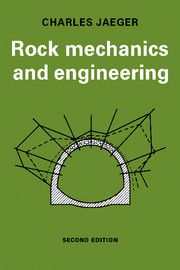Book contents
- Frontmatter
- Contents
- Preface
- Preface to the first edition
- Part 1 Introduction to rock mechanics
- 1 The historical development of rock mechanics
- 2 Engineering geology and rock mechanics
- Part 2 Rock material and rock masses
- Part 3 Rock mechanics and engineering
- Part 4 Case histories
- References
- Appendix 1 Comments on the bibliography
- Appendix 2 Measurement conversion tables
- Appendix 3 Table of geological formations and earth history
- Appendix 4 Some petrographic properties of rocks
- Author Index
- Index of geographical names, dam sites, reservoirs, tunnels and caverns
- Subject Index
1 - The historical development of rock mechanics
Published online by Cambridge University Press: 04 August 2010
- Frontmatter
- Contents
- Preface
- Preface to the first edition
- Part 1 Introduction to rock mechanics
- 1 The historical development of rock mechanics
- 2 Engineering geology and rock mechanics
- Part 2 Rock material and rock masses
- Part 3 Rock mechanics and engineering
- Part 4 Case histories
- References
- Appendix 1 Comments on the bibliography
- Appendix 2 Measurement conversion tables
- Appendix 3 Table of geological formations and earth history
- Appendix 4 Some petrographic properties of rocks
- Author Index
- Index of geographical names, dam sites, reservoirs, tunnels and caverns
- Subject Index
Summary
The first attempts at rock mechanics
At the end of last century, geologists studying the formation of the Alps were realizing that tremendous forces were necessary to lift continents and form their mountain chains. Mining engineers and tunnel experts watching rock bursts and rock squeezing in tunnels and galleries, suggested that some ‘residual forces’ were still at work in rock at great depth. The German tunnel expert Rziha (1874) was probably the first to be concerned with the horizontal component of the forces acting in many tunnels. A few years later Heim (Professor at Zurich University and at Zurich Federal Institute of Technology) suggested that the horizontal force component must be of the same order of magnitude as the vertical component and he forcefully stressed this opinion in several papers (1878–1912). It took many decades for geologists and engineers to realize the importance of the ideas of Heim and Rziha.
In 1920, the Ritom tunnel, which had just been built south of the Alps by the Swiss Federal Railways, was severely damaged. Inspection showed many longitudinal fissures running along the tunnel. The rock strata had a general dip towards the valley and it was feared that water seepage could cause a rock slide. The tunnel was repaired.
At that time, the Swiss Federal Railways were also building the Amsteg tunnel north of the Alps. They decided to start pressure tests in this second tunnel.
- Type
- Chapter
- Information
- Rock Mechanics and Engineering , pp. 1 - 4Publisher: Cambridge University PressPrint publication year: 1979



